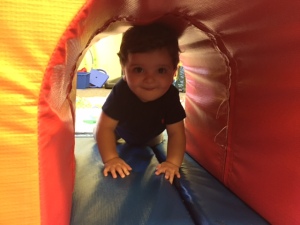This past week we looked at Self-Help skills during our developmental playgroups. Here is a brief overview of some of the things discussed. We will provide more detail in coming weeks!
Birth- 4 months:
- Express the need for food by crying
- Signal the need for diaper changes
- Express pleasure when placed in warm water (bathing)
- Will eventually begin to help by using their own hands to guide the nipple
4-8 months:
- Show interest in feeding activities
- Can pull off their own socks
- Can velcro closures on clothing
8-12 months:
- Begin to hold their own cup and drink
- Begin to eat finger foods
- Begin to pull off soiled or wet diaper
- Begin to sleep until 6 or 8 am.
12-24 months:
- Use a spoon to some degree to feed themselves
- Have good control of a cup
- Begin to try and wash themselves
- Begin to help with dressing
- By age 2 they may begin to gain control of bowels and bladder
24-36 months:
- Increasingly able to feed self and use cup/glass
- Can generally undress themselves
- Show signs of being ready for toilet training
Activities/ Things to remember when teaching or promoting self help skills:
- Decreasing amount of assistance given during activities (ie less assistance with silverware during mealtimes)
- Establish a routine/create a daily schedule
- Focus on the learning instead of the length of time to finish the task
- Rewards are best when naturally occurring in the environment
7 Self-Care Milestones to Look Forward To:
As the sense of self increases, so will your child’s achievements in self-care. He’ll naturally develop and fine-tune his motor skills over the next three years to master:
- Using a fork and spoon: Some toddlers start wanting to use utensils as early as 13 months, and most children have figured out this all-important skill by 17 or 18 months. By age 4, your child will probably be able to hold utensils like an adult and be ready to learn table manners.
- Undressing: While the ability to take his own clothes off may lead to lots of naked-toddler chase sessions, it’s a key accomplishment. Most children learn to do it sometime between 13 and 24 months.
- Toothbrushing: Your child may start wanting to help with this task as early as 16 months, but probably won’t be able to handle a toothbrush skillfully until sometime between her third and fourth birthdays. Even then, dentists say, kids can’t do a thorough job on their teeth until much later.
- Pediatric dentists recommend that parents do a thorough brushing of their kids’ teeth every night until school age or later. As a compromise, if your child is eager to brush, let her do the morning brushing herself. Or let her brush first, and then you finish up.
- Washing and drying hands: This skill develops at 24 months or so and is something kids should learn before or at the same time as using the toilet – you don’t want your child spreading germs.
- Getting dressed: Your little one may be able to put on loose clothing as early as 24 months, but he’ll need a few more months before being able to manage a T-shirt, and another year or two after that before he’ll really be able to get dressed all by himself. Also at 24 months, he’ll probably be able to pull off his shoes.
- Using the toilet: Most kids aren’t physically ready to start toilet training until they’re at least 18 to 24 months old. Two key signs of readiness for a child include being able to pull her pants up and down by herself and knowing when she has to go before it happens.
- Preparing breakfast: Toddlers as young as 3 may be able to get themselves a bowl of cereal when they’re hungry, and most kids can do it by the time they’re 4 1/2. If your child wants to give this a whirl, make it easy by leaving kid-size containers of cereal and milk in the cupboard and fridge.
References:
- http://www.floridahealth.gov/AlternateSites/CMS-Kids/providers/early_steps/training/itds/module1/lesson1_3.html
- http://www.earlychildhoodnews.com/earlychildhood/article_view.aspx?ArticleID=676
- http://www.childcarequarterly.com/summer08_story2.html
- http://www.babycenter.com/0_toddler-milestone-self-care_6503.b








